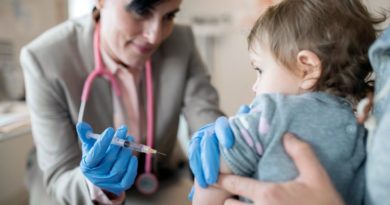3 charts that help explain how Americans feel about vaccines

Last month the Centers for Disease Control and Prevention reported that childhood vaccination rates dipped in 2023. Meanwhile, another recent survey found that fewer than half of Americans are planning to get updated COVID-19 shots, and under 14% of adults had done so as of Oct. 19, according to CDC data. These figures demonstrate a larger trend: changing attitudes toward vaccines in the United States. The factors driving this shift are complex and, sometimes, sensitive. To help simplify this topic, we broke it down into two interconnected issues illustrated using three charts.
Most states now fall short of federal targets for kids’ vaccination rates
Every state legally requires children to get vaccinated against various diseases before starting school. These vaccination programs practically wiped out polio and measles in the United States, and the CDC estimates that required shots prevented 508 million cases of illness and more than 1.1 million children’s deaths between 1994 and 2023.
But now there are measles outbreaks. Polio was detected in New York wastewater in 2022. This emergence of “eradicated” illnesses can be attributed, in part, to the fact that the share of kindergartners who have gotten all of their recommended vaccines has fallen. In fact, only 11 states have hit the federal target of getting 95% of kids immunized with two doses of the measles, mumps and rubella (MMR) shot, and just 12 states have hit the 95% coverage target for DTaP (diphtheria, tetanus and pertussis) and polio vaccination, according to the CDC.
Meanwhile, fewer Americans view childhood vaccination as important, a Gallup poll found in August. And “there’s been a steep rise in parents asking for vaccine exemptions,” which most states will grant for religious and, in some cases, other reasons, Dr. Peter Hotez, dean of the National School of Tropical Medicine at Baylor College of Medicine and co-director of the Texas Children’s Hospital Center for Vaccine Development, tells Yahoo Life.
Americans’ trepidation about childhood vaccinations isn’t new. Debunked claims that various immunizations cause neurological issues or autism have had a grip on some people since the 1980s. In their wake, childhood vaccination rates fell and, today, false claims circulate widely and unregulated on social media. These unfounded concerns about childhood shots helped to establish a baseline level of hesitancy and fuel concerns and misinformation about COVID-19 vaccines when they were introduced in December 2020. “Now it’s come full circle,” with anti-COVID vaccine sentiments fueling misgivings about childhood immunizations, Hotez says. “We’re going to see the return of diseases we thought we’d eliminated,” he adds.
Less than half of Americans have gotten or plan to get COVID shots
Now hesitancy about childhood and COVID vaccines influences one another, and the effect has spread to flu shots too. Last year 55.4% of U.S. kids got their flu shots — the lowest rate in 12 flu seasons. Adult flu vaccine coverage briefly increased amid COVID in the 2020-2021 season but has fallen steadily since, hitting a six-year low last year, according to the CDC.
COVID shots are faring even worse. Despite the agency’s estimation that the rapid uptake of COVID vaccines prevented more than 200,000 deaths in the first 10 months that the shots were available, by late October of 2022, only about 17% of Americans had gotten that year’s updated shot, according to the Department of Health and Human Services. During the 2023-2024 respiratory virus season — between October and April in the U.S., typically — just 22.5% of Americans got the updated shot.
As of Oct. 19, only 13.5% of adults had gotten this year’s newly formulated COVID vaccine, according to CDC tracking, which also reports that just over 15% of people in the U.S. “definitely” plan to do so. A September Ohio State University Wexner Medical Center poll resulted in a higher rate of intent to get vaccinated: 43% of Americans said they have done it or plan to do so. But that figure changed dramatically with political affiliation. Just 28% of Republicans said they’d get vaccinated, compared to 66% of Democrats.
Misinformation is an oft-cited driver of vaccine hesitancy, but “I think it’s a broader polarization and mistrust in authority,” Kai Ruggeri, a professor in the Department of Health Policy and Management at Columbia University Mailman School of Public Health, tells Yahoo Life. “When polarization sets in, people start checking information they’re told against the groups they’re affiliated with,” he explains. “Now the issue becomes political,” says Ruggeri, adding that this politicization cuts both ways, further entrenching people of each party in whatever their beliefs are.
Counteracting this misinformation is an important aspect of restoring trust in public health and vaccines. That requires not just telling those who are uncertain that they’re wrong, but listening to them and making it easy to say yes to a vaccine by providing clear answers to their questions and accessible, affordable ways to get shots, Dr. Tom Frieden, president and CEO of Resolve to Save Lives and former director of the CDC, tells Yahoo Life. Frieden cites his experience of talking to about 20 people who were vaccine-hesitant. “These folks had completely reasonable questions but had felt not just ignored, but vilified for the questions they were asking,” says Frieden. “When I and others listened to them, most wanted to get vaccinated.”


